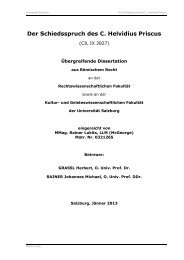(post) Keck Case Law on the Freedom to Provide Services
(post) Keck Case Law on the Freedom to Provide Services
(post) Keck Case Law on the Freedom to Provide Services
Create successful ePaper yourself
Turn your PDF publications into a flip-book with our unique Google optimized e-Paper software.
lawfully provides similar services.” 99In subsequent cases like Arblade 100 <strong>the</strong> Court c<strong>on</strong>tinued <strong>to</strong> use this restricti<strong>on</strong> approach butwith a slightly altered formula that referred <strong>to</strong> a restricti<strong>on</strong> which is liable <strong>to</strong> “prohibit,impede or render less advantageous” <strong>the</strong> activities of a service provider. 101 Sometimes <strong>the</strong>Court will also refer <strong>to</strong> “measures which prohibit, impede or render less attractive <strong>the</strong>exercise of” <strong>the</strong> freedom <strong>to</strong> provide services. 102 The restricti<strong>on</strong>-test applies <strong>to</strong> allindistinctly applicable measures and c<strong>on</strong>sists of two parts. The first part defines <strong>the</strong> noti<strong>on</strong>of restricti<strong>on</strong> in <strong>the</strong> meaning of Art 56 TFEU, which is reminiscent of <strong>the</strong> broad definiti<strong>on</strong>in Dass<strong>on</strong>ville. 103 The sec<strong>on</strong>d part refers <strong>to</strong> <strong>the</strong> lawful provisi<strong>on</strong> of (similar) services in <strong>the</strong>home State of <strong>the</strong> service provider.The sec<strong>on</strong>d part of <strong>the</strong> test makes a reference <strong>to</strong> <strong>the</strong> home State law of <strong>the</strong> serviceprovider. 104 This mimics <strong>the</strong> Cassis approach of mutual recogniti<strong>on</strong> which is based <strong>on</strong> <strong>the</strong>lawful producti<strong>on</strong> of a good in <strong>the</strong> home State of <strong>the</strong> trader. This was already argued by99<str<strong>on</strong>g>Case</str<strong>on</strong>g> C-76/90, Säger, [1991] ECR I-4421, para 12.100Joined <str<strong>on</strong>g>Case</str<strong>on</strong>g>s C-369 & 376/96, Arblade, [1999] ECR I-8453; see also <str<strong>on</strong>g>Case</str<strong>on</strong>g>s C-165/98, Mazzoleni andISA, [2001] ECR I-2189, para 22; C-49/98, Finalarte, [2001] ECR I-7831, paras. 22-23 and recently C-515/08, San<strong>to</strong>s Palhota, nyr.101See for example Joined <str<strong>on</strong>g>Case</str<strong>on</strong>g>s C-369 & 376/96, Arblade, [1999] ECR I-8453, para 33.102For example <str<strong>on</strong>g>Case</str<strong>on</strong>g> C-500/06, Corporación Dermoestética, [2008] ECR I-5785, para 32.103Analysed in more detail below in C.3.3.2 (a).104Note <strong>the</strong> discussi<strong>on</strong> with regard <strong>to</strong> <strong>the</strong> home State principle in c<strong>on</strong>text of <strong>the</strong> <strong>Services</strong> Directive. See forexample Barnard, 45 CML Rev. (2008), pp. 328 ff.32




